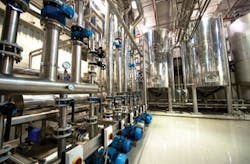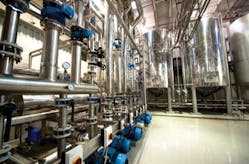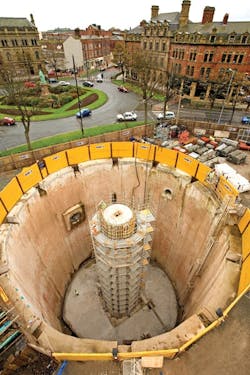The James River Treatment Plant (JRTP) is one of nine major treatment plants operated by the Hampton Roads Sanitation District (HRSD) in southeast Virginia. The plant discharges into the James River, a major tributary to the lower Chesapeake Bay. To meet the goals of the James River Waste Load Allocation, the Virginia Department of Environmental Quality issued HRSD a permit for Total Nitrogen (TN) from seven of these plants. HRSD determined meeting the TN mass load would require upgrading the JRTP to produce an annual average TN concentration of 10 mg/l.
The plant is bound by the James River to the west, houses to the north, a park to the east, and a historical farm to the south. Due to these site constraints, additional aeration tanks and clarifiers could not be constructed.
HRSD began evaluating IFAS (Integrated Fixed Film Activated Sludge) technologies in order to use the existing tank volume.
A major design challenge was to retrofit the existing 200 foot by 25 foot plug flow reactors with pre-anoxic zones for TN removal, an aerobic Hybas zone for BOD removal and nitrification, and a final swing zone to ensure the 1.0 mg/l of ammonia effluent limit.
Plant Overview
The James River Treatment Plant treats an average daily flow of 15.9 mgd. Max month flows are 20 mgd and peak hour flows are 50 mgd. The existing treatment processes consisted of ¼ inch screens, grit removal, primary clarifiers, nine plug flow aeration tanks with fine bubble diffusers, final clarifiers, and disinfection. Wasted biological solids from the final clarifiers are combined with the primary solids and anaerobically digested. Digested solids are dewatered using centrifuges and the centrate is normally returned to the aeration basins.
In early 2007, HRSD requested proposals from IFAS system suppliers to provide equipment for a demonstration project in which one of the nine plug flow reactors would be partitioned into pre-anoxic zones and an IFAS zone.
The IFAS process contains both free-floating biomass (MLSS) as well as biomass attached to a polyethylene media. The attached biomass increases the total biomass in the aeration tanks permitting more treatment in the same volume. The plastic media is retained in the aeration tanks by cylindrical screens with 5 mm slots, which allow the MLSS to pass through to the final clarifiers.
The AnoxKaldnes Hybas™ (Hybrid Activated Sludge) process was selected. Per the recommendations of AnoxKaldnes and the engineer, the demonstration train was divided into three anoxic zones, one aerobic IFAS zone approximately ½ of the total tank volume, and one swing zone. This option significantly saved the plant capitol costs and new construction was not required.
The potential for media migration due to bulk liquid velocity in the narrow plug flow tank was mitigated by installing internal recycle pump stations at both the upstream and downstream ends of the IFAS tank. By using the upstream pump station, the flow to the effluent end was reduced, preventing media migration to the IFAS stage effluent wall.
The demonstration train went on line in October of 2007 and was thoroughly studied through June of 2009.
The demonstration reactor achieved the desired effluent TN and ammonia concentrations. The owner decided to proceed with an AnoxKaldnes retrofit for all of the treatment trains. The engineer prepared a bid package to modify all nine reactors with a Kruger AnoxKaldnes Hybas process. Contractor bids were taken in April 2009. The first Hybas reactors are scheduled for startup in 2010.
Kruger's scope of supply included the 104,000 feet of AnoxKaldnes K3 type media for the nine Hybas reactors, medium bubble aeration grids, media retention screens, internal mixed liquor recycle pumps, and submersible mixers for the anoxic zone tanks.
Conclusion
With Kruger's AnoxKaldnes Hybas system on line, the James River Treatment Plant is reducing the Total Nitrogen discharged into the James River, all while maintaining the existing footprint of the facility and reusing the existing tanks. WW
Kruger® is an exhibitor at the WEFTEC.10 event and can be found at Booth No. 5650
More WaterWorld Current Issue Articles
More WaterWorld Archives Issue Articles





